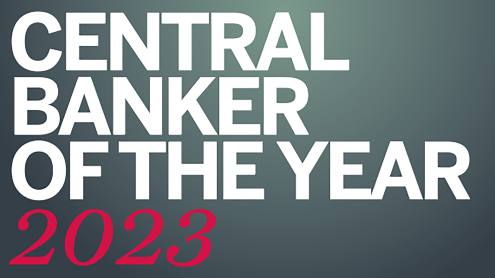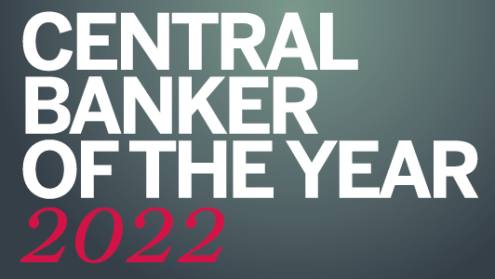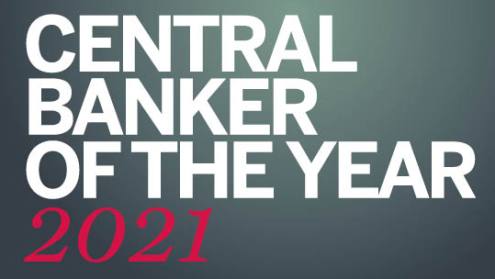Global and Asia-Pacific
Raghuram Rajan, governor, Reserve Bank of India
India is the one global economy that arguably weathered the capital outflow and currency storms in emerging markets that were fuelled by uncertainty over the US Federal Reserve interest rate hike in 2015. At 7.4%, India’s 2015 third-quarter gross domestic product growth was the strongest among large economies; the rupee was one of the few stable emerging market currencies in 2015; and a clear financial market liberalisation path is attracting foreign investors and making India’s financial markets more sophisticated.
In recognition of the Reserve Bank of India’s (RBI) contribution to these achievements, The Banker has awarded Raghuram Rajan with the title of Global and Asia-Pacific Central Bank Governor of the Year.
When Mr Rajan started his mandate, the rupee was in freefall. In September 2013, the currency hit a record low of Rs68.12 to the US dollar. Under Mr Rajan’s watch, the rupee’s depreciation halted and the currency moved back below the Rs60 ‘psychological mark’. In 2015, the rupee held up while currencies such as the Malaysian ringgit fell by as much as 20% against the dollar.
RBI’s focus on taming inflation – India is set to hit its 6% target in 2016 – was key to this performance and reinforced foreign investors’ confidence in India’s currency and rupee-denominated assets. “They are offering a healthy yield. And it wouldn’t be healthy if inflation were high,” says Mr Rajan.
Foreign investment is needed now that India is on a fiscal consolidation path. To help increase flows, the RBI is gradually opening up the market to foreign portfolio investment. “The worst thing for a foreign investor is to have a whole lot of money coming into a market, the country not being able to handle it, and capital outflows leaving damage,” says Mr Rajan.
Market liberalisation is also developing the offshore rupee (Masala) bond market, which is a means for Indian issuers to tap the international investor pool and to broaden green financing in India – the fourth largest polluter in the world. In a supportive policy move, RBI allowed local banks to issue infrastructure and green bonds in 2014. To Mr Rajan, the next step for green financing involves getting more Indian investors interested in green bonds.
Meanwhile, the RBI added green initiatives, non-conventional energy sources and social infrastructure to the sector group that needs to account, by law, for at least 40% of Indian banks’ lending portfolios.
In the banking sector, the RBI is also addressing the tricky issue of public sector banks, which are poorly capitalised and are heavy in non-performing assets (NPAs). In an unprecedented policy move, the RBI offered capital only to the nine most profitable public banks in 2014 before returning to a sector-wide capital infusion. Although short lived, it was at least an attempt to weed out the weakest banks, say analysts.
“We need to give banks power to deal with distressed debt… because India does not have an efficient bankruptcy or corporate resolution system,” says Mr Rajan. Consolidation is a solution in the medium term, but premature mergers might lead to a potentially bigger problem, he adds.
The RBI licensed 23 new banks in 2015 – including four mobile payment firms and one e-payment company – as a further way to make the banking sector more competitive. India has gone without new banks for decades. “Hopefully the old banks will feel compelled to start offering the same new products to match the new entrants,” says Mr Rajan.
Central Banker of the Year, Europe
Mark Carney, governor, the Bank of England
The past year was a quiet one for UK monetary policy, as expectations of an interest rate hike faded amid economic volatility in the largest emerging markets. However, Bank of England governor Mark Carney has been anything but static, devoting his attention to the global discussions on financial regulation.
As chairman of the Financial Stability Board (FSB), Mr Carney brokered a deal on a central component for ending the problem of too-big-to-fail banks, known as total loss-absorbing capacity (TLAC). Announcing the final standard in November 2015, Mr Carney said it “testifies to the FSB’s co-operative, consensual and member-led approach”. TLAC is also testament to some deft handling by Mr Carney himself, after responses to an earlier draft in November 2014 had highlighted deep divisions between the US, Europe and China, all of whose banks have very different business models and structures.
Mr Carney has been at the forefront of efforts to prevent financial sector misconduct. The Australian chairman of the International Organisation of Securities Commissions, Greg Medcraft, credited the UK’s pioneering June 2015 Fair and Effective Markets Review, initiated by Mr Carney, as the inspiration for the international response to scandals such as the manipulation of financial benchmarks. The UK Senior Managers Regime represents the most progressive legislation to inculcate accountability in the financial sector, and Mr Carney was ready to hold his own organisation to similarly high standards, proposing reforms to the Bank of England.
“The announcement that the Bank of England will have a smaller unitary board, one assumes with clearer responsibilities set out for each member, in many ways reflects the basis and thought process behind the Senior Managers Regime,” says Michael Ruck, a financial services enforcement lawyer at Pinsent Masons.
Ahead of the climate summit in Paris in December, Mr Carney set the tone by announcing a disclosure task force to examine climate risks in the financial sector. The Carbon Tracker Initiative praised Mr Carney for confirming “the need for financial markets to take climate risk into serious consideration and acknowledge that an abrupt transition to a low-carbon economy is a financial stability risk”.
After such a broad sweep of initiatives, 2016 is likely to take the governor back to core central bank territory: the timing of the first interest rate hike since July 2007.
Central Banker of the Year, Americas
Agustin Carstens, governor, Central Bank of Mexico
A subdued global economy, the fall in commodity prices, particularly oil, and expectations of tightening in US monetary policies were the main challenges Mexico faced in 2015. “The last two factors, in particular, affected our exchange rate and so our real challenge was to reduce the impact of the exchange rate depreciation onto prices as much a possible. So far, we’ve been quite successful,” says Mexico’s central bank governor Agustin Carstens. “We’re closing [the year] with an inflation rate close to 2%, much lower than our objective, and we feel satisfied about this.”
The bank’s inflation target is 3%. The wide-ranging structural reforms that are being implemented played a big role in these results by opening up to competition the energy and telecom sectors. As a result, prices for electricity, gasoline and telecom services have fallen. Furthermore, thanks to a large gas network project that links Mexico to neighbouring Texas, consumers and manufacturers will soon enjoy even cheaper energy prices thanks to the US shale gas market.
“What is making Mexico very competitive is the fact that we will be able to enjoy the very low prices of shale gas from Texas; this will enhance the competitiveness of our manufacturers substantially. This is one of the factors that we feel can make a difference for Mexico next year,” says Mr Carstens.
Furthermore, as the US economy continues to pick up, Mexican exporters are set to benefit from its neighbour’s growing demands for cheaper goods. Buoyant economic prospects are set to make the Mexican central bank’s monetary policy work easier, and Mr Carstens predicts a gross domestic product growth rate of 2.5% for 2016, a healthy rate considering current global conditions.
As the award for Central Bank Governor of the Year for the Americas is given to Mr Carstens just as the International Monetary Fund’s leadership position might be up for grabs again, The Banker is compelled to ask him about a second attempt to run it. His candidacy in 2011 was seen as the best bet emerging markets had to lead the organization, which has traditionally been headed by a European name. “Christine Lagarde has done a really good job, so she’s a very good candidate for re-election,” says Mr Carstens. “If she doesn’t want to do it, then a selection process should be established and the best in the world should be chosen.”
This will not include him, however. “I’m just starting my second term as governor and I’m very happy here,” he says.
Central Banker of the Year, Middle East
Ziad Fariz, governor, the Central Bank of Jordan
As the conflicts in Syria and Iraq continue to rage, Jordan’s economic potential has taken a hit. With trade, tourism and investor confidence on the wane, the country’s authorities have had to act quickly to mitigate the impact of these external challenges. Under the experienced leadership of governor Ziad Fariz, the Central Bank of Jordan (CBJ) has been instrumental in ensuring that the country's growth trajectory has maintained momentum, while opening up new sectors of the economy by supporting small and medium-sized enterprises (SMEs) and microfinance organisations.
“Despite the turbulent regional environment, growth picked up in the second quarter of 2015, and is projected to reach 2.5% by the end of the year before further recovering to more than 3% in 2016,” says Mr Fariz.
To support the financial sector and promote enhanced credit risk management, the central bank has licensed the country’s first private sector credit bureau, which is expected to become operational in 2016. The CBJ is also providing extensive support to the country's SMEs, particularly in productive sectors including industry, agriculture and renewable energy, through low-interest-rate loans via local banks in partnership with international organisations.
“The CBJ is fully aware of the need to manage local and regional developments in sync with global changes, and to build on reform measures implemented since 2012 to ensure monetary and financial stability, and to create a favourable investment environment for economic growth,” says Mr Fariz.
In March 2015, the central bank launched Jordan’s first real-time gross settlement system. Linking 26 financial institutions across the country, the system is seen as a major step forward for its financial sector. It will also allow for the processing of sharia-compliant products.
To support the wider economy, the CBJ has been praised for its timely and judicious interventions when reducing its key monetary policy rate. For the sixth time since July 2013, the CBJ cut its benchmark lending rate by 25 basis points, amounting to a cumulative reduction of 250 basis points over that period.
“International reserves are at an adequate level, while credit to the private sector continues to improve, benefiting from a series of monetary policy measures taken by the CBJ, while banking sector indicators remain sound,” says Mr Fariz.
Central Banker of the Year, Africa
Abdellatif Jouahri, governor, Bank Al-Maghrib
As a result of rising agricultural output, Morocco’s economy gained some traction in 2015 after enduring a mixed couple of years. The International Monetary Fund (IMF) expects gross domestic product growth of 4.7% for the year, although a slower-than-expected recovery in the country’s main trading partner, Europe, as well as normalising agricultural activity, means that this momentum should moderate in 2016 with growth expected to reach 3.7%.
Meanwhile, the Moroccan authorities have been working hard to implement key structural reforms as a means of reducing vulnerabilities in the country’s economy. The Bank Al-Maghrib, the country’s central bank, has been at the forefront of these efforts. Led by veteran central banker, Abdellatif Jouahri, a number of key changes were implemented in 2015 to support Morocco’s economic development.
For one, in January 2015 the central bank developed a regulatory framework for Islamic banking. With the first Islamic banking licences expected to be issued in the coming 12 months, the move answers growing demand in the country for sharia-compliant products and services. In doing this, Morocco will adopt a centralised higher sharia-authority, modelled after the structure established in Malaysia, to develop jurisprudence around Islamic financial products.
Meanwhile, in response to the weakening of the euro against the US dollar, Bank Al-Maghrib revised the structure of the dirham’s peg in April 2015, in what was described by the bank as the first step in the transition towards a more flexible exchange regime. As such, the US dollar weighting was doubled to 40%. This occurred as the weighting of the euro declined from 80% to 60%.
The move received the support of the IMF, which stated that a more flexible exchange rate system would promote more diversified financial flows while mitigating the impact of shocks on the economy.
The central bank has also been instrumental in developing a more enhanced method of supervision for Moroccan lenders pushing into sub-Saharan Africa. For instance, Bank Al-Maghrib requires prior authorisation before new international expansion occurs. For the country’s banks with significant cross-border activities, there is a requirement to submit an annual update on their three-year business plans for activities beyond the domestic market. Moreover, the central bank has established a code of conduct for all banking operations in sub-Saharan Africa, which is monitored through a dedicated African Committee.






